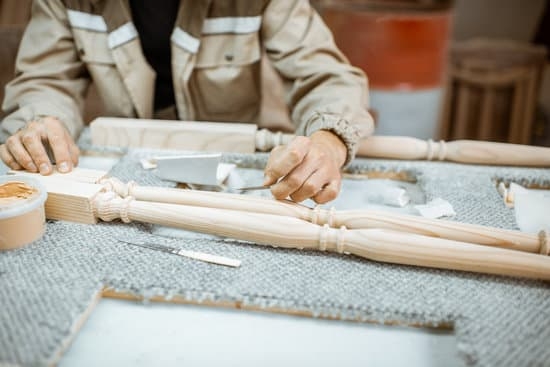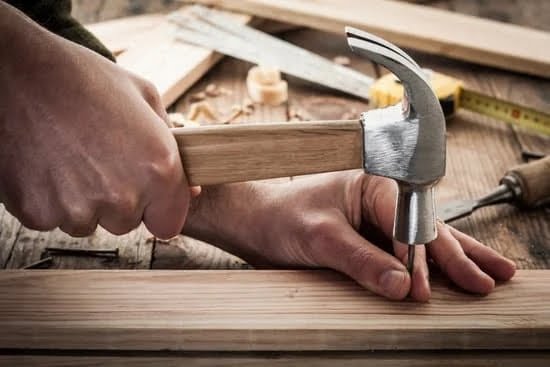No nails woodworking is a traditional technique that allows woodworkers to join wood pieces without using any nails. This method not only adds an aesthetic appeal to the finished projects but also creates a stronger and more durable bond between the wood pieces. In this article, we will delve into the world of no nails woodworking, exploring the art of joining wood without relying on fasteners.
Through the history of no nails woodworking, we will uncover the origins and evolution of this age-old technique. From ancient civilizations to modern-day artisans, the practice of joining wood without nails has been passed down through generations, evolving into a sophisticated craft that continues to thrive in contemporary woodworking.
One of the key advantages of no nails woodworking is its ability to create seamless joints that enhance both the visual appeal and structural integrity of a piece. By eschewing traditional nail joining methods, woodworkers are able to showcase their skills in craftsmanship and elevate their projects to a higher level of artistry. Join us on this journey as we explore the benefits, tools, techniques, examples, and tips for perfecting the craft of no nails woodworking.
History of No Nails Woodworking
The history of no nails woodworking dates back centuries, with evidence of this traditional technique found in ancient civilizations such as Egypt, Rome, and China. This method of joining wood without the use of nails or screws was born out of necessity due to the scarcity or expensive nature of metal fasteners in earlier times. Craftsmen developed intricate joinery techniques that not only held wooden pieces together securely but also added a decorative element to the final piece.
One of the most well-known traditions of no nails woodworking is Japanese joinery, which has been refined over thousands of years. Japanese carpenters are famous for their precise and complex joinery techniques, such as the mortise and tenon joint, dovetail joint, and many others. These methods not only create strong connections between wood pieces but also showcase the skill and craftsmanship of the individual artisan.
As woodworking evolved over time, different cultures adapted and developed their own unique methods of no nails joinery. In Europe, particularly during the Middle Ages, craftsmen used dovetail joints, tongue and groove joints, and pegged mortise and tenon joints to construct furniture and buildings without relying on metal fasteners. This historical background highlights the rich tradition and enduring appeal of no nails woodworking in today’s modern era.
| No Nails Woodworking Technique | Origin |
|---|---|
| Japanese Joinery | Japan |
| Dovetail Joints | Europe (Middle Ages) |
Benefits of No Nails Woodworking
No Nails Woodworking, also known as joinery without the use of nails or screws, has been a popular technique among woodworkers for centuries. One of the main reasons why artisans choose this method over traditional nail joining is the aesthetic appeal it offers. Without unsightly metal fasteners disrupting the natural beauty of the wood, pieces created using no nails woodworking have a clean and seamless look that highlights the craftsmanship involved.
In addition to aesthetics, another benefit of no nails woodworking is the structural integrity it provides. Traditional nail joining can weaken wood over time due to movement, moisture, and other environmental factors. On the other hand, joinery techniques such as dovetail joints, mortise and tenon joints, and tongue and groove joints used in no nails woodworking create strong connections that enhance durability. This results in furniture and structures that are not only visually appealing but also long-lasting.
Furthermore, by utilizing the no nails woodworking technique, woodworkers are able to showcase their skills and expertise in a unique way. Mastering the art of joinery without relying on nails requires precision, patience, and a deep understanding of wood properties. This method allows artisans to challenge themselves creatively while producing high-quality pieces that stand out. Whether creating furniture, cabinetry, or outdoor structures, choosing no nails woodworking can elevate a project from ordinary to extraordinary.
| Benefits | Details |
|---|---|
| Aesthetic Appeal | Clean and seamless look without visible metal fasteners |
| Structural Integrity | Durable connections that withstand environmental factors |
| Showcasing Skills | Opportunity for artisans to demonstrate precision and expertise |
Tools and Materials Needed for No Nails Woodworking
When it comes to engaging in no nails woodworking, there are certain essential tools and materials that are necessary for a successful project. The beauty of this traditional technique lies in its simplicity, but having the right equipment is crucial to ensuring sturdy and long-lasting joinery. Even though nails are not used, precision and quality craftsmanship are still paramount in creating beautifully joined pieces.
Tools
One of the primary tools needed for no nails woodworking is a high-quality wood chisel. Chisels come in various sizes and shapes, allowing woodworkers to carve out precise joints without the need for nails. A mallet or hammer is also essential for driving the chisel into the wood with controlled force. Additionally, a handsaw or a table saw may be used to cut wood pieces to size before joining them together without nails.
Materials
In addition to having the right tools, selecting the appropriate materials is crucial for successful no nails woodworking. High-quality hardwoods such as oak, maple, or walnut are often preferred due to their durability and strength. Wood glue is an essential material for bonding wood joints securely without relying on nails. Some woodworkers also use wooden dowels or biscuits to reinforce joints and add extra stability to their projects.
Clamps
Furthermore, clamps play a vital role in holding pieces of wood together while the glue dries, ensuring a tight and secure fit between joints. Various types of clamps are available, including bar clamps, pipe clamps, and band clamps, each suitable for different types of woodworking projects that involve no nails. Having an assortment of clamps on hand will help guarantee accurate alignment and solid bonds between wood pieces within your projects using this technique.
Techniques of No Nails Woodworking
No nails woodworking is a traditional technique that has been around for centuries, allowing woodworkers to create beautiful and durable pieces without the need for nails or screws. This method involves joining pieces of wood together using various types of joints and fasteners such as dovetails, mortise and tenon joints, and wooden pegs. By mastering the techniques of no nails woodworking, craftsmen are able to create long-lasting furniture and structures that showcase the natural beauty of the wood.
To effectively join wood without using nails, woodworkers must pay close attention to detail and precision in their work. Here are some step-by-step guidelines on how to practice the art of no nails woodworking:
- Choose high-quality hardwoods for your project, as they provide better strength and durability compared to softwoods.
- Measure and mark the areas where you will be joining the pieces of wood together, ensuring that they fit snugly without gaps.
- Use traditional hand tools such as chisels, saws, mallets, and hand planes to create precise joints that will hold the wood pieces securely in place.
By following these techniques and utilizing the right tools, woodworkers can achieve seamless joints that not only hold up well over time but also enhance the overall aesthetic appeal of their creations. No nails woodworking provides a sense of pride and craftsmanship that cannot be replicated with modern fastening methods, making it a timeless art form that continues to inspire artisans around the world.
Examples of No Nails Woodworking Projects
No nails woodworking is a technique that has been around for centuries, allowing woodworkers to create strong and durable joints without the need for metal fasteners. By using traditional methods such as mortise and tenon joints, dovetail joints, and even complex interlocking joinery, craftsmen can achieve stunning results that showcase the natural beauty of wood. If you are looking for some inspiration for your next woodworking project, consider trying out some of these no nails woodworking ideas:
- Japanese-style Sawhorse: Create a sturdy sawhorse using traditional Japanese joinery techniques such as the Kumiko joint. This project will not only be functional but also a beautiful piece to display in your workshop.
- Floating Shelf: Achieve a clean and modern look by constructing a floating shelf without any visible hardware. Using techniques like tongue and groove or sliding dovetails, you can create a seamless design that showcases the natural grain of the wood.
- Puzzle Box: Challenge yourself by crafting a puzzle box with intricate interlocking pieces that require precise craftsmanship to assemble. This project will not only test your woodworking skills but also provide you with a unique piece to showcase in your home.
By exploring these examples of no nails woodworking projects, you can see the endless possibilities this technique offers for creating beautiful and functional pieces without relying on traditional nail joining methods. Whether you are a seasoned woodworker looking to expand your skills or a beginner eager to learn more about this ancient craft, experimenting with no nails woodworking can open up a world of creativity and innovation in your projects.
Advantages and Disadvantages of No Nails Woodworking
No nails woodworking, also known as joinery without the use of nails or screws, has been a popular practice among woodworkers for centuries. This traditional technique involves creating strong and durable joints by fitting pieces of wood together in precise ways, relying on the natural properties of the wood itself to hold everything in place. The process requires skill, patience, and attention to detail, but the results are often stunning and long-lasting.
One of the main advantages of no nails woodworking is the aesthetic appeal it brings to the finished piece. Without visible metal fastenings disrupting the natural beauty of the wood, furniture and other items created using this method have a clean and seamless look that is both timeless and elegant. Additionally, because no nails are used, there is no risk of corrosion or rust over time, helping to ensure the longevity of the project.
On the other hand, one potential disadvantage of no nails woodworking is the steep learning curve involved in mastering this technique. Properly cutting and fitting wood joints without the aid of nails requires a high level of precision and craftsmanship, which can be challenging for beginners or those unfamiliar with woodworking techniques.
Additionally, certain projects may require additional reinforcement or support to ensure stability when nails are not used. Despite these challenges, many artisans find great satisfaction in honing their skills in no nails woodworking and appreciate the unique beauty it brings to their creations.
Tips and Tricks for Perfecting No Nails Woodworking
No nails woodworking is a traditional technique that has been used for centuries to join wood without the need for metal fasteners. Perfecting this craft requires skill, patience, and the right tools. In this section, we will explore some expert tips and tricks to help you master the art of no nails woodworking.
Choose the Right Wood
One of the key aspects of successful no nails woodworking is selecting the right type of wood. It is essential to choose hardwoods that are strong and durable, as they will provide better stability and longevity to your project. Softwoods may not be suitable for projects that require sturdy joints without nails. Additionally, pay attention to the grain direction of the wood to ensure proper joint strength.
Use Proper Joinery Techniques
Incorporating traditional joinery techniques such as dovetail joints, mortise and tenon joints, or tongue and groove joints can enhance the structural integrity of your woodworking project. These methods provide a strong bond between pieces of wood without relying on nails or screws. Take the time to practice these techniques and perfect your skills for seamless connections that stand the test of time.
Utilize Clamping Techniques
Clamps are essential tools in no nails woodworking as they help hold pieces in place while glue dries during assembly. Utilize different types of clamps such as bar clamps, pipe clamps, or C-clamps depending on the size and shape of your project. Proper clamping ensures that joints are tight and secure, creating a professional finish without relying on nails for reinforcement.
By incorporating these tips and tricks into your woodworking practice, you can elevate your skills in no nails woodworking and create beautiful pieces with durable joints that stand out for their craftsmanship and elegance. Mastering this traditional technique opens up endless possibilities for creating unique projects with seamless connections that showcase the beauty of natural wood without any visible fasteners.
Conclusion
In conclusion, no nails woodworking offers a unique and traditional approach to joining wood that has stood the test of time. By exploring this technique, woodworkers can delve into a rich history of craftsmanship and innovation that dates back centuries. The art of creating sturdy and beautiful pieces without relying on nails opens up a world of creative possibilities, allowing for intricate designs and seamless connections that showcase the natural beauty of wood.
The benefits of no nails woodworking go beyond just aesthetics. This method provides added strength to the structure, as the joinery is often more secure and durable than nail-driven construction.
Woodworkers who embrace this technique also appreciate the challenge and skill required to master it, leading to a sense of accomplishment when completing a project solely through joinery techniques. Additionally, by eliminating nails from the equation, furniture made through no nails woodworking can be easily repaired or disassembled for maintenance or transportation purposes.
As modern technology continues to advance, the art of no nails woodworking remains relevant and sought after by those who value tradition, craftsmanship, and sustainability in their craft. Whether you are a seasoned woodworker looking to expand your skills or a beginner eager to learn a new technique, exploring the world of no nails woodworking offers endless opportunities for creativity and innovation in an age-old practice that continues to inspire makers around the globe.
Frequently Asked Questions
How Do You Attach Wood to Wood Without Nails?
Wood can be attached to wood without nails by using alternative methods such as glue, screws, dowels, or biscuits. These techniques provide a strong bond and can be used in various woodworking projects.
What Is It Called When You Build Without Nails?
Building without nails is often referred to as joinery or traditional woodworking. This method involves using interlocking joints, such as dovetails, mortise and tenon, or finger joints, to hold the pieces of wood together without the need for nails or screws.
Can You Build Without Nails?
Yes, it is possible to build structures without nails by utilizing different joinery techniques and woodworking methods. While nails are commonly used for convenience and speed, traditional woodworking skills allow for creating sturdy and durable structures without relying on metal fasteners.

Hi everyone! I’m a woodworker and blogger, and this is my woodworking blog. In my blog, I share tips and tricks for woodworkers of all skill levels, as well as project ideas that you can try yourself.



